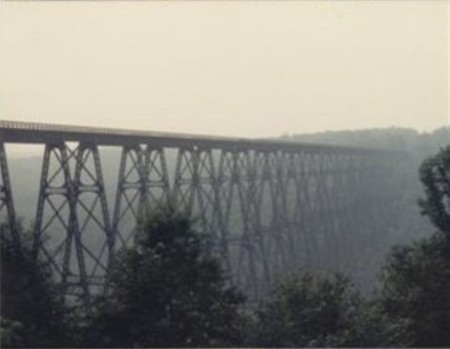 |
Pennsylvania's Engineering
Marvels -
The Kinzua Viaduct The Kinzua Viaduct towers over its
surroundings.
|
 |
Pennsylvania's Engineering
Marvels -
The Kinzua Viaduct The Kinzua Viaduct towers over its
surroundings.
|
| A Bridge Twice Built:
The idea to build what would be come the Kinzua Viaduct was the brainchild of General Thomas Kane, the Civil War hero who was a stakeholder in the New York, Lake Erie & Western Railroad. His idea was to find a way to cross the Kinzua Valley by rail vs. a winding six mile route through the valley. He along with Octave Chanute, a civil engineer, agreed that a viaduct high above the Kinzua Valley would be the best choice. They hired the Phoenix Bridge Works Company, who later constructed the Pecos River High Bridge in Texas, to build the viaduct. Preliminary construction began in 1881 when the foundations of the bridge's 110 stone piers were laid. To build the piers, 7,600 cubic yards of hard limestone was needed. (1) The following year, construction of the viaduct itself began on April 10. 94 days later, the viaduct was complete. Immediately thereafter, word of the accomplishment spread throughout Pennsylvania and the Northeast, and numerous excursion trains visited the Kinzua Valley over the next 30 years. Erecting the viaduct was certainly an accomplishment. Just shy of 302 feet high and at a length of 2,053 feet, the bridge was built without any scaffolding. When one wrought iron tower was completed, a wooden crane was built at the top of that tower to assist the construction of the next tower. The 40 man crew used this process to build what was then the world's highest and longest rail bridge ever built. The bridge cost the railway $167,000. (1) As trains and their payloads grew heavier, the ability of the viaduct to handle such loads came into question. The bridge narrowly missed a devastating blow in 1889 when a train derailment saw three rail cars crash into the valley. High winds were also a concern. The winds were severe enough that a five mile an hour limit was in place. A new bridge was necessary, and in May of 1900, the iron viaduct was closed to traffic. Construction of a new steel bridge soon began. The construction of the new viaduct started on May 24th; the entire ironworks were torn down and replaced by the sturdier steel structure. Building the new bridge lasted only 105 days, and on September 25, 1900, rail service returned to the viaduct. The new Kinzua Viaduct was built by the Elmira Bridge Company. The new bridge retained the original height (301.5') and length (2053') of the original. However, the steel structure was much heavier. The new bridge consisted of 6,715,000 pounds of steel vs. the 3,105,000 pounds of iron used on the original viaduct 18 years earlier. (1) Centerpiece of a
State Park:
The park opened in 1970; and in addition to the bridge, the park offered hiking and picnicking. In 1977, the viaduct was added to the National Register of Historic Civil Engineering Landmarks. A decade later, and after nearly 30 years of silence, trains once again crossed over the Kinzua Valley on the now historic viaduct. The Knox and Kane Railroad, formed in 1986, began a passenger excursion route with the viaduct as the main attraction. Their first train crossed the viaduct in August 1987. With the addition of the excursion train, the park became highly successful attracting nearly 140,000 visitors a year. (2) A Tragic End:
The question then arose on what to do with the bridge. Various individuals and local groups voiced their opinion in preserving the bridge. In February 2003, crews began a $10 million project to rehabilitate, stabilize, and strengthen the viaduct. Unfortunately, the work to refurbish the Kinzua Viaduct was never finished. The second misfortune to the Kinzua Viaduct occurred on the stormy afternoon of July 21, 2003. Around 3:15 p.m. that Monday, the bridge was partially destroyed by a tornado that rolled through the valley. The tornado destroyed eleven of the towers that stood in the center of the span. The entire center of the viaduct collapsed to the valley floor below. In 2004, the DCNR decided not to rebuild the damaged viaduct as they considered it too costly. The following February the Knox and Kane filed suit against the DCNR for compensation for the loss of the use of railroad facilities, specifically the rail lined owned by the K&K north of the viaduct, as a result of the tornado. The law suit which was originally for $106,000 and eventually settled for $12,500. (5) That April, the K&K announced it would no longer offer excursion trains to Kinzua Bridge State Park, as interest in the route decreased. Finally in 2006, the Knox and Kane railroad would cease operations. Currently, there are no excursion trains to the site of the damaged viaduct. Kinzua Viaduct and Valley
Photos:
|
| Site Navigation:
© 2007-10 William Lawson |